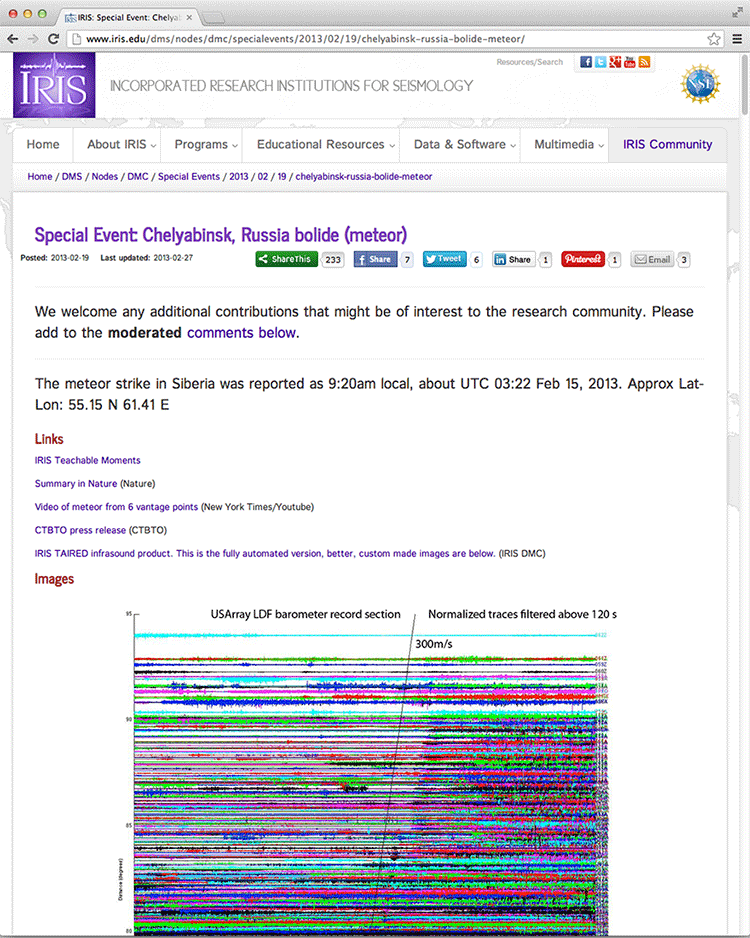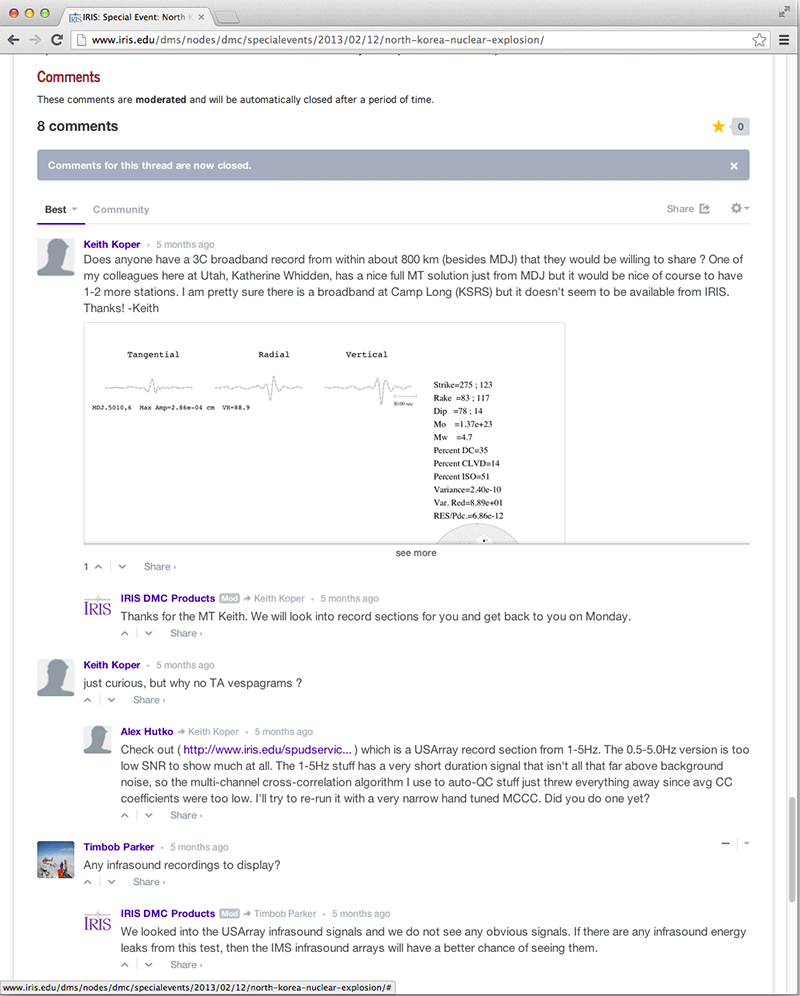IRIS DMC Special Event Webpages
Introduction
The IRIS DMC has recently completed an effort to create community-driven web-pages for special events. Special events are events considered to be of interest to the research community, and the web-pages created serve to collect and share preliminary and informal research results to the global research community. To foster the sharing of findings for such events, IRIS provides web pages that allow researchers to present data, plots, animations, and other supporting material that describe the nature of the event.
Background
Social media among earth scientists has become an increasingly popular forum for sharing informal or cutting-edge research results. The IRIS DMC wants to be an integral part of this exchange of scientific information, and has vast quantities of both archival- and real-time data from instruments deployed around the globe as well as derived data products. As a globally recognized data center, IRIS saw an opportunity to provide a platform for recent research results related to interesting (or special) events to be presented conveniently in one place.
Criteria
Defining a special event is a subjective exercise, but one of the driving factors in developing the special events application is to not replicate content already distributed by IRIS, the USGS, the CTBTO or any other organization. The decision to create a special event page for an event is based on:
- uniqueness: the event type has to be uncommon. Examples include nuclear explosions, bolide (meteor) strikes, or a particularly unusual earthquake swarm.
- impact on the general public: a magnitude 9.0 earthquake will always get a special event page as will other rare and/or catastrophic events that captivate the seismology community’s interest.
Content
The content of the special event pages is also different than, and complementary to, other organizations, and is targeted to the undergraduate level and higher education. K-12 content is not created. Rather, results and figures are contributed by researchers for other researchers.

Community driven
By design, the special event pages allow fellow research scientists the ability to very easily add their own content, comment on existing content, or request new types of content. Using modern web-development technologies it is relatively simple to allow researchers to add comments and/or content to the special event pages. We are using a commonly used commenting engine called Disqus for community discussion. Comments are moderated to ensure discussion stays on topic and meets civility standards. Comments range from the
check out this visualization I created
to
could you please create a visualization of parameter X using data-set Y for this event please?
So far we have been impressed with the breadth of comments and contributions from the research community.

Case studies
- North Korean nuclear explosion: The February 12th, 2013 nuclear test in North Korea was the third reported test in recent years. Many of the contributed figures and results related to this event allowed for quick comparisons with the previous two events and a natural earthquake of comparable magnitude.
- Chelyabinsk, Russia bolide (meteor) strike: The February 15th, 2013 bolide strike in Siberia was a rare event that was detected by infrasound sensors deployed on Earthscope’s USArray network of instruments and by seismic stations in the Global Seismic Network (GSN) network. Comparison between the signal generated by the event and signal generated by a seismic event during the same time period shows how infrasound and coupled seismic waves generated by the impact compare with traditional seismic waves from an earthquake.
Statistics
We anonymously tracked the number of visitors to the special event web-pages (post-publication and mailing list announcements) and were surprised to discover how popular they were. From the February 14th announcement date of the first special event page to the current date (March 27th, 2013), all special event pages have generated 7063 pageviews from 4588 unique visitors who spent an average of 02:26 minutes on the page. The North Korea event alone generated 3380 pageviews from 2105 visitors who spent an average of 02:50 minutes on the page. An interesting statistic is the number of visitors who chose to visit other IRIS web pages after accessing a special event page – the bounce rate for the North Korea page is almost 70%, which means IRIS engages just over 30% of visitors in additional web-based content after the special event page has been consumed. This has implications in driving traffic to other parts of the IRIS website. See Table 1 below for a full analysis.
Table 1: Analysis of statistics, courtesy Google Analytics
| Page | Pageviews | Unique Pageviews | Avg. Time on Page | Bounce Rate |
|---|---|---|---|---|
| North Korea Nuclear Explosion | 3,380 | 2,105 | 00:02:50 | 69.91% |
| Chelyabinsk, Russia bolide | 2,743 | 1,888 | 00:03:06 | 75.36% |
| Tohoku, Japan earthquake | 776 | 502 | 00:02:23 | 69.75% |
| Special Events landing page | 164 | 93 | 00:01:26 | 0.00% |
Conclusion – Get involved!
If you have interesting preliminary research results from a recent event that you wish to share informally with your colleagues please contact us. We are hoping, especially with comments and research contributions, to engage with the research community as much as possible.
by Rob Newman (IRIS Data Management Center) , Alex Hutko (IRIS Data Management Center) , Manoch Bahavar (IRIS Data Management Center) and Chad Trabant (IRIS DMC)






